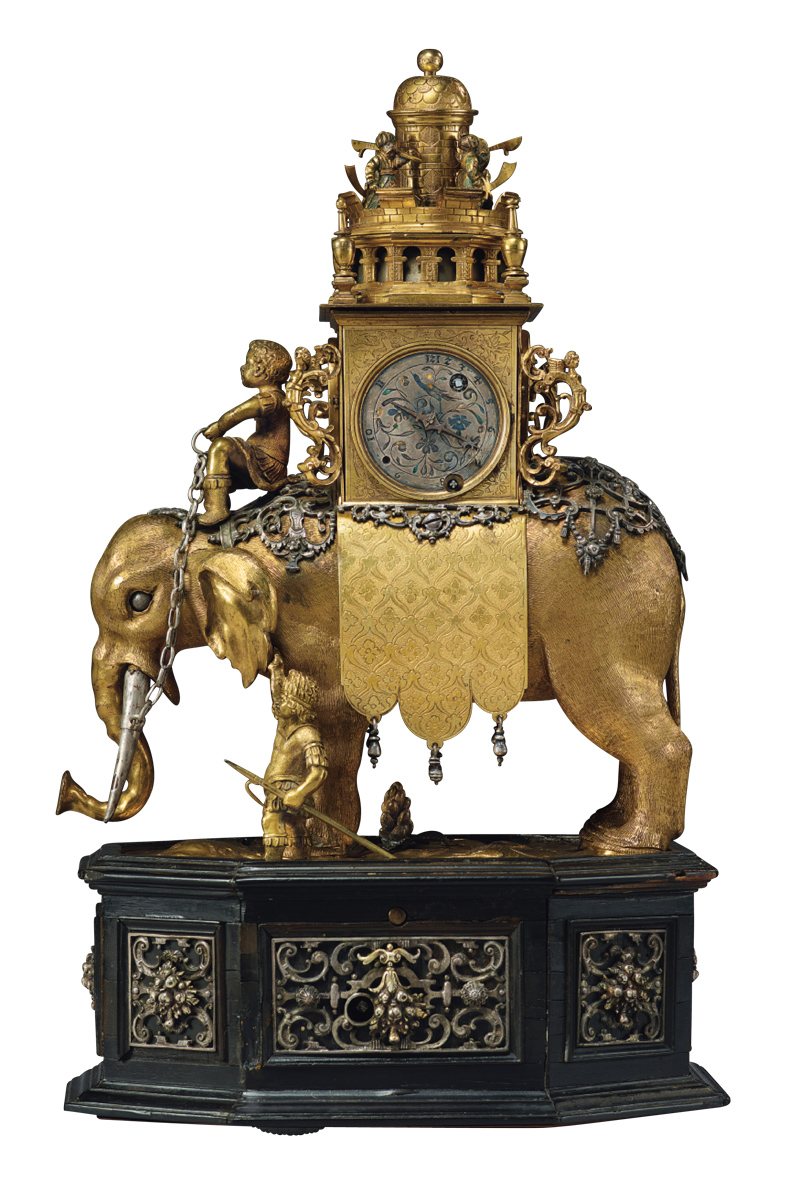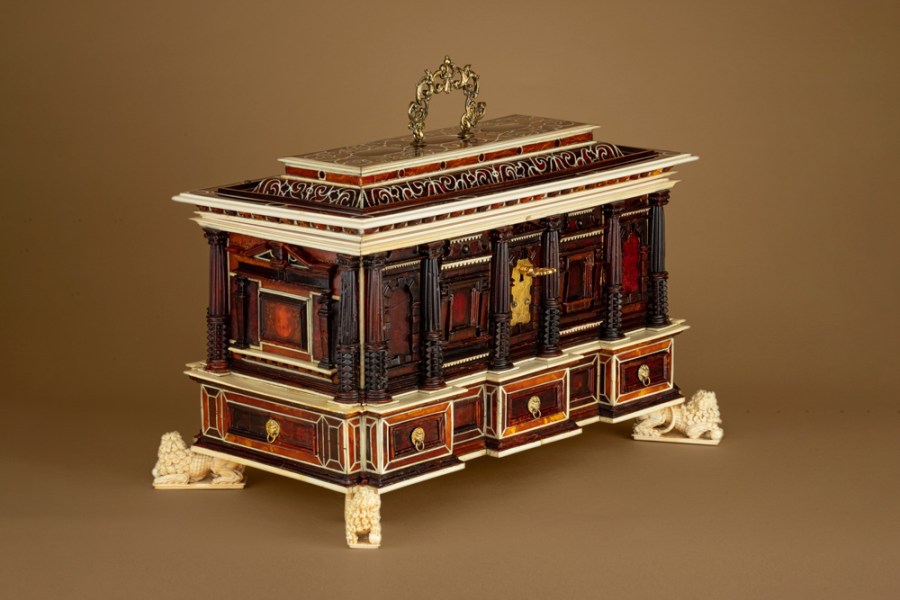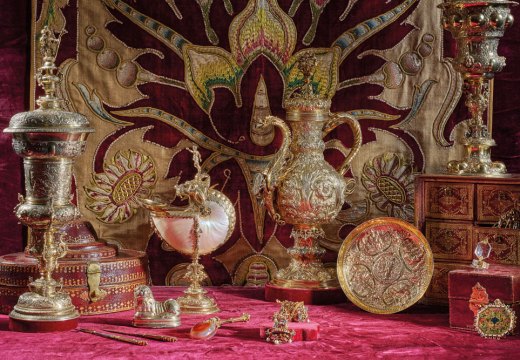From the October 2023 issue of Apollo. Preview and subscribe here.
Between 1550 and 1700, collecting became an essential activity for monarchs, merchants and scholars throughout Europe. The world was opening up at unprecedented speed: rediscovery of the ancient world and its wisdom, as revealed through artefacts and literature, was occurring in tandem with the first voyages of Europeans to what was dubbed the ‘New World’. Science and technology promised a dazzling future, while lavish royal patronage encouraged artisans to scale ever-greater heights of ingenuity. For those rulers who sought to master this expanded universe, owning objects that represented all these fields became an essential tool of statecraft, inspiring awe in visitors.
The Kunstkammer or Wunderkammer – the cabinet of art and the cabinet of curiosity – became the theatres for a new style of collecting. These were born of the Italian studiolo, as epitomised in the painting Saint Augustine in His Study (1502) by Vittore Carpaccio.
Outstanding objects were gathered together into purpose-built cabinets or small rooms for study and scrutiny. These items belonged to the categories of naturalia (natural specimens, hard stones and creatures), exotica (unfamiliar plants and animals, but also artworks made from shells, amber, coral, coconut, rock crystal and other exotic materials), artificialia (intricate caskets, fine goldsmithing, meticulously crafted glass and small-scale sculptures made from bronze, box wood, wax and ivory) and scientifica (scientific instruments).
By the early 18th century, more systematic displays were deemed preferable, and the popularity of the Kunstkammer began to wane. Today, however, the kind of object it contained is much in demand again. Scarlett Walsh, associate specialist at Christie’s London, says: ‘The focus in a Kunstkammer object is on the skill of the making, the craftsmanship. Collectors are looking for the best of the best.’ Sought-after objects, she suggests, include Renaissance bronzes, small-scale antiquities such as Roman cameos, and automata – clocks or mechanical moving figures in precious metals. She cites the elephant-shaped automaton clock, made in Augsburg circa 1600–10, which sold in Christie’s New York in October 2021 for $2.6m, against an estimate of $700,000–$1m. Walsh reflects: ‘Typically objects need to come from the high point of collecting for the Kunstkammer, the 16th and early 17th century, with provenance especially important.’

Automaton clock (c. 1600–10), Augsburg. Christie’s New York, $2.6m. Photo: courtesy Christie’s New York
Beyond the Medici and significant European princes, later provenance from a Rothschild collection or similar can significantly influence demand. The elephant clock, for instance, was restituted to the heirs of Maximilian Baron von Goldschmidt-Rothschild in 2021, having come into the family through Maximilian’s Rothschild wife. Christie’s held a sale titled ‘Modern Medici: Masterpieces from a New York Collection’ in January 2023 in New York, underlining the fact that Gilded Age industrialists also shared a taste for Renaissance grandeur. A bronze écorché man cast from a model by Willem Danielsz. van Tetrode from the late 16th- to early 17th-century fetched $1.5m (estimate $800,000–$1.2m).
Limoges enamels of the French Renaissance are also highly sought after. This July, three plates attributed to the 16th-century master Jean de Court depicting the Adoration of the Shepherds, Adoration of the Magi and the Visitation, each with the coat of arms of the de Vic family, sold for £189,000 against an estimate of £50,000–£80,000 at Christie’s London from the collection of Alice and Nikolaus Harnoncourt. This month, Christie’s will mount Rothschild Masterpieces, a series of auctions in New York. Objects come from the collection of Baron James de Rothschild, his wife Betty and their sons Alphonse and Gustave, whose taste came to epitomise the ‘goût Rothschild’. Notable Kunstkammer objects include a Dutch nautilus cup (1607) bearing the mark of Cornelis Jansz. van der Burch, estimate $100,000–$150,000, and a Limoges enamel-covered tazza (1553) by Pierre Reymond, estimate $70,000–$100,000.
Virginie Spenlé, of the dedicated Munich dealership Kunstkammer Georg Laue, says that while some collectors ‘seek certain types of objects, such as scientific instruments or goldsmithing works […] most collectors drawn to Kunstkammer objects fall under the spell of these wondrous artworks that were specifically created between the 16th and 18th centuries to captivate the attention of the viewer.’ She notes that curators are eager to add Kunstkammer pieces to museum collections: ‘It is important to emphasize that the Kunst- and Wunderkammer was already, by the 17th century, a collection space open to the public with the goal of not only amazing, but also instructing. In this regard, it serves as a precursor to the modern museum.’ Since the 1990s there has been concerted scholarship in the field, reflected in exhibitions such as ‘Making Marvels: Science & Splendor at the Courts of Europe’ at the Met in 2019 and by efforts at the Wadsworth Atheneum. Kunstkammer Georg Laue is currently offering an intricately carved ivory sculpture called ‘The Rothschild Oliphant’, adorned with three-dimensional intertwined animals, made in Strasbourg around 1645 by Johann Michael Egner. It has an elaborate mount of fire-gilt silver by the Strasbourg master Hans Jacob Erhart (price on application).
Christopher Hamlyn of Worcestershire- based Mayflower Antiques has observed strong interest in early Venetian glass, designed to show off the play of light that could be achieved with then-new technologies. Hamlyn has a large reticello piece from the late 16th/ early 17th century (priced at £28,000), made when one cup of spiralled filigree glass canes is blown inside another such cup; the intersecting canes trap tiny pockets of air. ‘Reticello glass was at the cutting edge, culturally and scientifically,’ Hamlyn notes.
Laura Kugel, of established specialists Galerie Kugel in Paris, comments: ‘A noticeable market trend, pushed by both private collectors and museums, is the interest in so-called “global objects” – works that attest to intercultural fascination and early global trade routes. Think of ostrich eggs or coconut cups mounted in silver, for instance.’ This is confirmed by the London-based dealer Matthew Holder, who currently has an Indo-Portuguese bowl made in Gujarat in the 16th or early 17th century of mother-of-pearl from the West Pacific, and then mounted in silver in England in the early 17th century. ‘There is keen interest in these hybrid, cross-cultural objects – the rarer and more exotic the better,’ he says. He adds that such objects are now harder to find, as this has become a global market. Kugel, too, notes: ‘Historically, most of our collectors for these objects were based in Europe, but since the past decade or so taste for these has spread to the United States and wider parts of the world.’ This month, Kugel is opening the exhibition ‘Amber: Treasures from the Baltic Sea, 16th– 18th Century’ (13 October–17 December). ‘We are showing works worthy of any 17th-century Kunstkammer, including several from former Rothschild collections,’ Kugel says. They also have a casket possibly given in 1607 to the Habsburg Holy Roman Emperor Rudolf II, whose legendary Kunstkammer filled a wing of Prague Castle. For Kugel, ‘It’s the ultimate Kunstkammer object.’
From the October 2023 issue of Apollo. Preview and subscribe here.
Unlimited access from just $16 every 3 months
Subscribe to get unlimited and exclusive access to the top art stories, interviews and exhibition reviews.












![Masterpiece [Re]discovery 2022. Photo: Ben Fisher Photography, courtesy of Masterpiece London](http://www.apollo-magazine.com/wp-content/uploads/2022/07/MPL2022_4263.jpg)
It’s time for the government of London to return to its rightful home